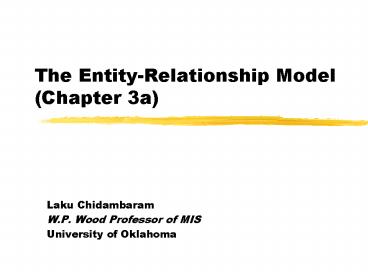The Entity-Relationship Model (Chapter 3a) - PowerPoint PPT Presentation
1 / 13
Title:
The Entity-Relationship Model (Chapter 3a)
Description:
(Note: may need to substitute simple keys for long, i.e., composite, keys) ... Composite Attributes ... CUSTOMER. Orders. PRODUCTS. CUSTOMER. ORDER. PRODUCTS ... – PowerPoint PPT presentation
Number of Views:44
Avg rating:3.0/5.0
Title: The Entity-Relationship Model (Chapter 3a)
1
The Entity-Relationship Model(Chapter 3a)
- Laku Chidambaram
- W.P. Wood Professor of MIS
- University of Oklahoma
2
Overview
- Database Design The E-R Model
- Entities
- Attributes
- Relationships
3
Database Design
Engineer (A/C Receivable)
Pilot (Order Entry)
Passenger (Inventory)
External View
4
The Entity Relationship Diagram
- An E-R diagram is a graphical representation of
an organizations data - Such data includes the people, places, objects,
events, or concepts (along with their
characteristics and relationships) that are
relevant to an organization
5
Entities
- Person, place, object, event, or concept about
which the organization wishes to collect and
maintain data - Nouns are used to describe entities
- Examples
- Employee, Student, Nurse
- City, State, Country
- Sale, Registration, Account
- Entity Type versus Entity Instance
6
Types of Entities
- Strong Entity can exist independently
- Weak Entity cannot exist without the owner
entity (with which it has an identifying
relationship) - Has a primary key that is derived from the owner
entity in the relationship
EMPLOYEE
DEPENDENT
EMPLOYEE
has
7
Attributes
- Properties or characteristics of entities (or
relationships) - Provide the actual data that describe entities
(or relationships)
EMPLOYEE
E_ID
E_Name
E_Address
8
Unique Attributes
- Candidate keys are ALL attributes that uniquely
define an instance of an entity - A primary key is the candidate key that is chosen
as the most unique of them all! - A primary key (or identifier) is ideal if it
- does not change over time
- has unique values that are not null
- does not use intelligent features
- (Note may need to substitute simple keys for
long, i.e., composite, keys)
9
Composite Attributes
- Attributes that are not atomic (or simple),
i.e., those attributes that can (and need to) be
broken down further
EMPLOYEE
E_ID
E_Name
E_Address (E_Street, E_City, E-Zip)
10
Multi-valued Attributes
- Some attributes may have multiple values ...
- but they may need to be fixed before
proceeding
EMPLOYEE E_Skill
EMPLOYEE
SKILL S_Code S_Name
has
11
Derived Attributes
- Those attributes whose values can be calculated
from the values of other attributes (either in
the database or in the system). - Value is not stored in the database (since it
does not take up any space) - E.g., Age can be calculated, where date-of-birth
is stored
12
Relationships
- Refer to the associations (or links) between
entities - Use verbs to describe the links
- May have attributes (in some cases)
- Are directional
STUDENT
DORMITORY
Lives in
EMPLOYEE
STORE
STORE
Works in
13
Associative Entities
- A (many-to-many) relationship that is better
represented as an entity because it - contains attributes from the entities it links
and has its own attributes - has independent meaning to end-users
CUSTOMER
PRODUCT
Orders
CUSTOMER
ORDER
PRODUCT































